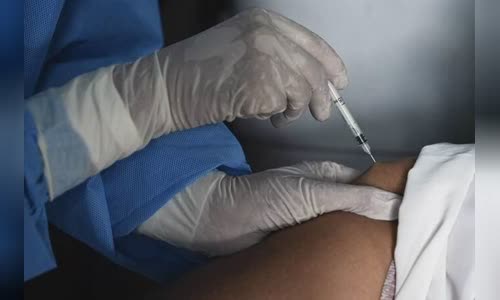nCoV has slowed for the third consecutive week, new infections are at their lowest level since late October, and the situation is particularly improving in South Africa.
Globally, there are 105,860,184 cases of infection and 2,306,698 deaths due to Covid-19.

Medical staff vaccinated an elderly woman in Yangon, Myanmar on February 5 Photo: AFP
The number of new daily cases fell below the half-million mark for the first time since late October, at 493,000, according to AFP statistics.
New cases fell in nearly every region of the world, with Africa down 27%, the US and Canada 17%, Europe, Latin America, the Caribbean 12% and Asia 2%.
Meanwhile, new infections increased slightly by 4% in the Middle East, while Oceania recorded 14 cases per day, up 43%.
The country recording the biggest decline was South Africa, the worst affected country in Africa, where the number of new cases fell 49%, at 4,100 cases per day.
South Africa discovered a more contagious nCoV variant and cases soared late last year, prompting the country to impose a curfew in late December 2020.
Lithuania recorded the second sharp decline of 37% (700 cases per day), Mexico (35%, 10,600), Japan (31%, 3,000), Panama (31%, 1,100) and Portugal (30%,
Malaysia was the country that recorded the fastest rate of nCoV spread, with a 30% increase in new infections (4,800 new cases per day).
The US remains the country that reports the highest new cases, with an average of 133,500 cases per day, down 17% from the previous week, according to AFP.
According to data from the New York Times on February 5, the average daily cases in the US peaked on January 8 with nearly 260,000 new infections.
Several regions in the US, including the Midwestern region, recorded a sharp decline in new CoV infections compared to other locations.
The major places where cases have experienced a sharp decline are mainly small-scale seeds, which have a relatively low total number of cases.
New cases are thought to be the most pronounced decrease in the Midwest region.
However, even as nCoV cases are currently on a downward trend across the United States, some regions are still seeing a rapid increase in cases compared to the epidemic peak experienced last year.
The state of Maine recorded relatively low new infections in November last year, but the numbers have steadily increased until they peaked at the end of January.
Experts say that in assessing the Covid-19 situation in the US, it is still necessary to consider factors such as whether the nCoV variant is causing the surge in cases and the impact of vaccination.
Americans are expected to receive $ 1,400 instead of $ 600 under the bailout package implemented from the end of December 2020.
Brazil recorded the second highest new cocoa increase in the world, averaging 48,200 shifts per day, down 16% from last week.
Brazil's Health Regulatory Authority on Feb. 3 said it would change requirements around the emergency vaccine use authorization, to allow approval of the vaccine to be tested outside the country.
The move will help increase supplies of vaccines in the country, the regulator said.
UK Health Minister Matt Hancock said on February 3 that more than 10 million people in the UK received the first shot of the vaccine, describing the milestone as "critically important".
He aims to give the first injection to all people over 70 years old, the vulnerable, and the frontline health workers by mid-February.
As of February 3, France has vaccinated 1.83 million people.
Spain has vaccinated 1.83 million people.
On a per capita basis, Portugal is the country with the highest number of cases, with 622 cases per 100,000 people.
The United States recorded the highest number of deaths in the past week, averaging 3,279 people per day, followed by Mexico (1,111), Brazil (1,035), UK (1,018), Germany (690), Russia (507) and



 Evangeline Cabiles
Evangeline Cabiles







